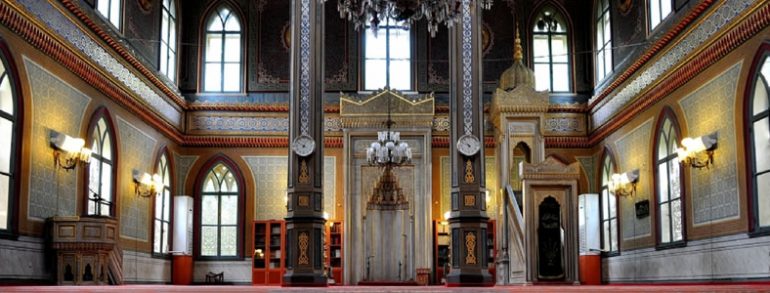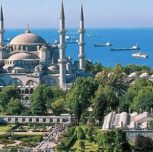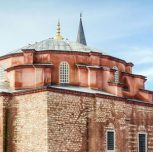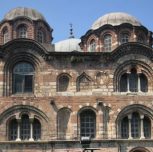This is the last imperial (selâtin) mosque of the Ottoman Empire. Imperial mosques had to be built by sultans and were financed only by their personal funds. Abdülhamid II was the last sultan to build a mosque. The last two sultans of the Ottoman Empire did not commission any mosques.
Hamidiye Mosque had a significant place in Abdülhamid II’s life. He spent most of his time within the walls of the palace. Of course, there were some exceptions and the Hamidiye Mosque was one of those exceptions. Abdülhamid II went to the mosque every Friday to pray and every visit of his was organized like a state ceremony. Even though the mosque was across from the palace, the sultan always used his horse carriage. Citizens, visitors and even foreigners used to meet outside the palace to see the sultan and watch the ceremony. This ceremony was so popular that the Set Pavilion with a road view, was situated in the first court of the palace, designed for official visitors to watch the ceremonies comfortably.
Erected on the base of 1,500 m2, the land of the mosque covers the area of 10,000 m2, surrounded by a fence. It has three entrances. The main entrance of the mosque is located on the north, on the main road in front of the palace.
The Yıldız Hamidiye Mosque, also known as the Yıldız Mosque, was constructed in 1886 by Sarkis Balyan, and fellow craftsman Dikran, 9 years after Abdülhamid II moved to Yıldız Palace.
It architecturally is a mixture of Neo-Gothic and Ottoman styles in a rectangular plan. The mosque has one minaret with a single balcony (şerefe), erected on the right side. The Hamidiye Mosque does not have a courtyard for late comers.
There are 16 windows under its small dome, which is supported by four columns made of wood-covered steel. This differs from the tradition, as the imperial mosques always had granite columns.
The mosque receives the daylight through 36 windows. The big bohemian crystal chandelier hanging from the center of the dome was the gift of Otto Eduard Leopold (1871-1890), Prince of Bismarck, the first Chancellor of the German Empire.
Hünkar mahfili (imperial lodge) is situated on the left side of the mosque, and şehzadeler mahfili (lodge for the sons of sultans) is on the right. The imperial lodge has more decoration than the other does. The imperial mosques always have a hünkar mahfili (imperial lodge); a private chamber reserved for the sultans and screened off by a gilded grill. It is usually in the far left corner of the prayer hall. Abdülhamid II always prayed in his private hünkar mahfili on Fridays and religious holidays.
Hamidiye Clock Tower is situated on the south-west corner of the Hamidiye Mosque.
Hamidiye Fountain (Hamidiye Çeşmesi), which carries Abdülhamid II’s signature (Tuğra), is located in the same garden.










